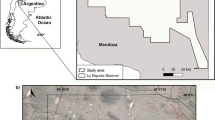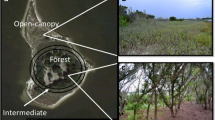Abstract
Whereas variation in pronghorn (Antilocapra americana) spatial organization is well documented, underlying ecological or physiological explanations are not well understood. This study quantitatively describes spacing systems of pronghorn males and correlates of their spatial organization. I collected behavioral data from two populations in South Dakota (Wind Cave) and Montana (Bar Diamond) to determine if males differed in space use, response to intruders, and behavior patterns indicative of area defense. I measured sex ratio and population density, and I examined characteristics of food resources, including forb species diversity, richness, coverage, biomass, and nitrogen content, and how they changed during the growing season. I also collected and analyzed fecal samples to determine if males differed in testosterone concentrations. Pronghorn males at Wind Cave were more territorial than males at Bar Diamond, although males at Bar Diamond became more territorial during the second year. The forb community at Wind Cave was more diverse, contained greater amounts of forbs later in summer, and had a higher nitrogen content later in summer. Population density was lower at Wind Cave, although density dropped at Bar Diamond during the second year, and sex ratios were skewed toward males at Bar Diamond. Finally, males at Wind Cave had higher testosterone concentrations than did Bar Diamond males, although differences were not statistically significant. With lower population density and higher forb abundance and quality, food resources were more economically defensible at Wind Cave, and males were more territorial there. Analyses using these and other pronghorn populations revealed that population density and sex ratio correlated weakly with spatial organization, whereas precipitation correlated most strongly, which suggests plant productivity has a powerful role in determining pronghorn territoriality.
Similar content being viewed by others
Author information
Authors and Affiliations
Additional information
Received: 16 June 1999 / Received in revised form: 21 September 1999 / Accepted: 31 December 1999
Rights and permissions
About this article
Cite this article
Maher, C. Quantitative variation in ecological and hormonal variables correlates with spatial organization of pronghorn (Antilocapra americana) males. Behav Ecol Sociobiol 47, 327–338 (2000). https://doi.org/10.1007/s002650050673
Issue Date:
DOI: https://doi.org/10.1007/s002650050673




